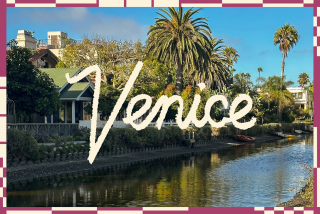Doctor Fights to Revive 1st Ghetto : Italy: Venice dermatologist spreads the word in an effort to rebuild what was once a flourishing community.
- Share via
VENICE, Italy — A historic Jewish community sprung from the world’s first ghetto is dying here, but it is too soon for tears. Great vigor and invention may yet stay the passing of Venice’s Jews.
From his dermatologist’s office overlooking Venice’s storied lagoon, Roberto Bassi is quietly advertising for immigrants. He spreads the word in want-ad chatter at international medical conferences and in encounters with tourists who come in increasing numbers to explore the rich past of Venice’s Jewish community.
“I’d like to meet with 500 families of emigrating Russian Jews and bring five of them home with me,” Bassi mused. “Even a few families would make a great difference. If they were professionals, so much the better. We could help them: a place to live, jobs. In a year they’d speak good Italian. And their children . . . they could become doctors, university professors, anything they like.”
There is movement and modernization aplenty today at the old island cannon foundry site that gave its name to all subsequent enforced settlements of Jews. ( Geto meant “foundry” in the medieval Venetian dialect.) But Bassi warns that unless there is also new blood, Venice will before long be left with carefully restored monuments to Jews without a Jewish community to enjoy and preserve them.
“We have great development and a very lively community, but at the same time we face the danger of extinction,” he said.
Indeed, it is ironic that survival of the Venetian Jewish community is threatened precisely at a moment when its old ghetto is better maintained, better known and more visited than ever. Nearly 1,000 tourists a week now visit a museum and five newly restored synagogues on two islands that, by order of the Doge in 1516, became the first ghetto. It was walled, locked by night and gave to literature Shakespeare’s Shylock, and to history moneylenders, pawnbrokers and generations of distinguished physicians.
“From very early, Venetian Jews were allowed as students and professors of medicine at the University of Padua. To this day, a disproportionate number of Venetian Jews are doctors,” said Riccardo Calimani, a journalist member of the Jewish community whose 500-page history of the Venetian ghetto is now in its seventh printing in Italy.
Venice’s Jewish community, in fact, is almost as old as Venice. The oldest grave at the Jewish cemetery on the Lido dates to 1386, and the population grew steadily to crest at about 5,000 in about 1650, according to Cesare Vivante, a part-time community historian.
Today, the decline of the Jews mirrors the alarming decay of Venice itself. More and more visitors come to fragile Venice. More and more Venetians leave for better housing and better jobs on the mainland.
Venice is hurting for people as badly as its Jewish community. The numbers, majority Roman Catholic and minority Jewish, have fallen in discouraging tandem since the end of World War II.
Venice at war suffered under occupation: It was annexed to the Third Reich in 1944. There was also more specific pain for Venetian Jews. About 200 Venetians--the old, the poor, a blind rabbi among them--were among 8,000 Italian Jews murdered in concentration camps. Bassi’s family, like most Venetian Jews who could afford it, fled wartime persecution. Until the Germans left, Bassi, a schoolboy with false documents, was sheltered at a Catholic orphanage in Rome.
“After the war, most of us came back, but many emigrated--to the big cities, to Israel, the U.S.,” said Bassi, who at 58 is head of dermatology at Venice’s largest hospital.
When the war ended, there were about 1,500 Jews among 200,000 Venetians. Today, with the city’s population about 80,000, only about 550 of Italy’s 30,000 Jews live in Venice.
There are still a few Jews in the old ghetto, but most of Venice’s 200 Jewish families are scattered across the city, as they have been since the ghetto died with the Venetian Republic in 1797. There are no Jews among the young Venetian guides who walk visitors through the ghetto.
Ghetto monuments have been restored with private funds and handsome contributions from the Italian government, but there is no rabbi: he left a few months ago for Trieste and a Hebrew school for his children.
Emigration, though, is less a threat now than age. About 100 of the remaining Venetian Jews are older than 70, Bassi says. Last year, two Jewish babies were born. Counting them, there are fewer than 50 Jewish children under the age of 10.
Amid nagging concern for the future, new life buds in the old ghetto. A new library is open, four new rooms have been added to a Jewish pensioners’ home and work begins this month to restore a 16th-Century apartment in one of the old ghetto tenements as a museum adjunct.
More to Read
Sign up for Essential California
The most important California stories and recommendations in your inbox every morning.
You may occasionally receive promotional content from the Los Angeles Times.













